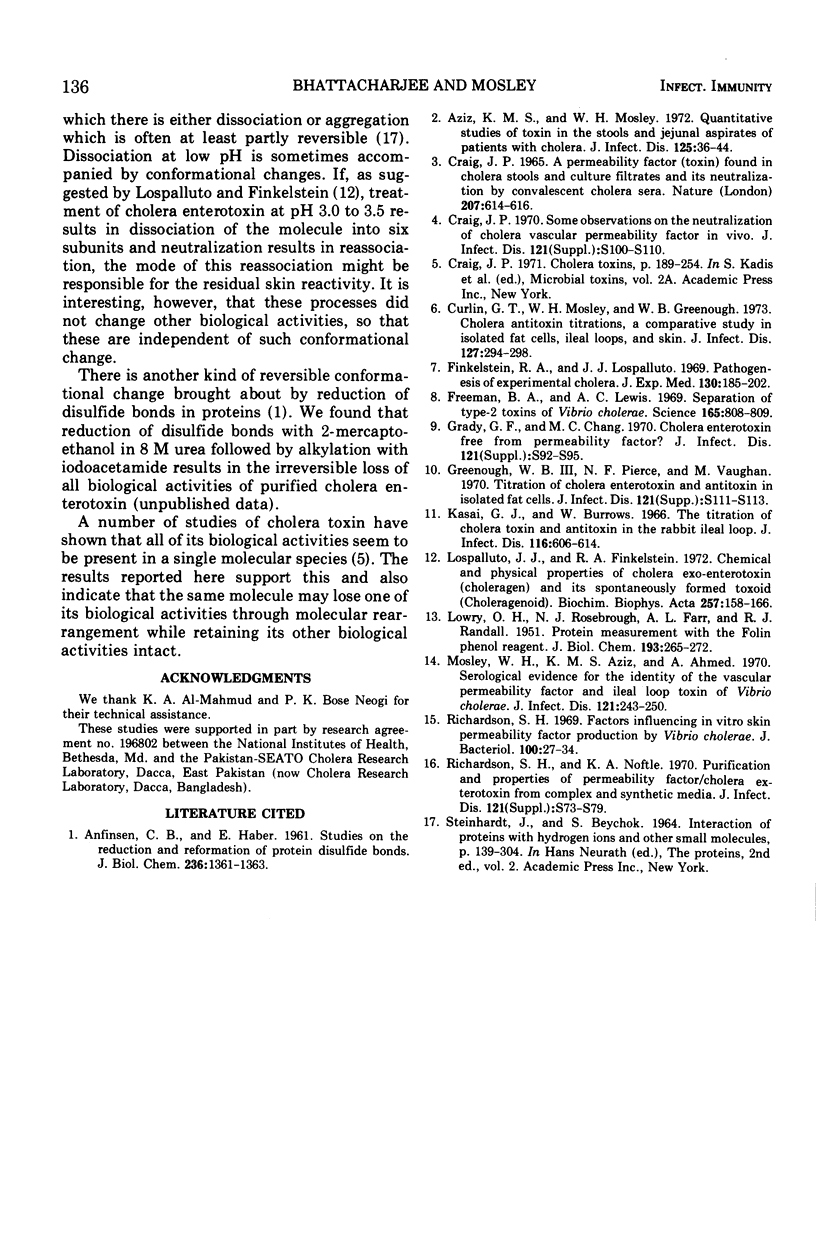Abstract
The effect of treatment of purified cholera enterotoxin with acid at pH 2.0 for 1 h followed by neutralization of the acid on the biological activity of the toxin has been studied. It was found that the material loses 85 to 96% of its skin permeability activity and this loss is neither reversed nor increased after 28 days of storage at 5 to 10 C. Other biological properties such as diarrheagenic activity, lipolysis-stimulating activity, and the lethal dose for mice remain unaffected by acid treatment. These observations indicate that the skin permeability activity is more sensitive to relatively minor changes in molecular structure than are the diarrheal, lipolytic, and mouse lethality activities.
Full text
PDF



Selected References
These references are in PubMed. This may not be the complete list of references from this article.
- ANFINSEN C. B., HABER E. Studies on the reduction and re-formation of protein disulfide bonds. J Biol Chem. 1961 May;236:1361–1363. [PubMed] [Google Scholar]
- Aziz K. M., Mosley W. H. Quantitative studies of toxin in the stools and jejunal aspirates of patients with cholera. J Infect Dis. 1972 Jan;125(1):36–44. doi: 10.1093/infdis/125.1.36. [DOI] [PubMed] [Google Scholar]
- Craig J. P. A permeability factor (toxin) found in cholera stools and culture filtrates and its neutralization by convalescent cholera sera. Nature. 1965 Aug 7;207(997):614–616. doi: 10.1038/207614a0. [DOI] [PubMed] [Google Scholar]
- Curlin C. T., Mosley W. H., Greenough W. B., 3rd Cholera antitoxin titrations: a comparative study of fat-cell, ileal-loop, and rabbit-skin assays. J Infect Dis. 1973 Mar;127(3):294–298. doi: 10.1093/infdis/127.3.294. [DOI] [PubMed] [Google Scholar]
- Dover A. S., Western K. A. Fatalities due to malaria in the United States, 1966-1969. J Infect Dis. 1970 May;121(5):573–575. doi: 10.1093/infdis/121.5.573. [DOI] [PubMed] [Google Scholar]
- Finkelstein R. A., LoSpalluto J. J. Pathogenesis of experimental cholera. Preparation and isolation of choleragen and choleragenoid. J Exp Med. 1969 Jul 1;130(1):185–202. doi: 10.1084/jem.130.1.185. [DOI] [PMC free article] [PubMed] [Google Scholar]
- Kasai G. J., Burrows W. The titration of cholera toxin and antitoxin in the rabbit ileal loop. J Infect Dis. 1966 Dec;116(5):606–614. doi: 10.1093/infdis/116.5.606. [DOI] [PubMed] [Google Scholar]
- LOWRY O. H., ROSEBROUGH N. J., FARR A. L., RANDALL R. J. Protein measurement with the Folin phenol reagent. J Biol Chem. 1951 Nov;193(1):265–275. [PubMed] [Google Scholar]
- Lewis A. C., Freeman B. A. Separation of type 2 toxins of Vibrio cholerae. Science. 1969 Aug 22;165(3895):808–809. doi: 10.1126/science.165.3895.808. [DOI] [PubMed] [Google Scholar]
- Lospalluto J. J., Finkelstein R. A. Chemical and physical properties of cholera exo-enterotoxin (choleragen) and its spontaneously formed toxoid (choleragenoid). Biochim Biophys Acta. 1972 Jan 26;257(1):158–166. doi: 10.1016/0005-2795(72)90265-6. [DOI] [PubMed] [Google Scholar]
- Mosley W. H., Aziz K. M. Serological evidence for the identity of the vascular permeability factor and ileal loop toxin of Vibrio cholerae. J Infect Dis. 1970 Mar;121(3):243–250. doi: 10.1093/infdis/121.3.243. [DOI] [PubMed] [Google Scholar]
- Richardson S. H. Factors influencing in vitro skin permeability factor production by Vibrio cholerae. J Bacteriol. 1969 Oct;100(1):27–34. doi: 10.1128/jb.100.1.27-34.1969. [DOI] [PMC free article] [PubMed] [Google Scholar]


